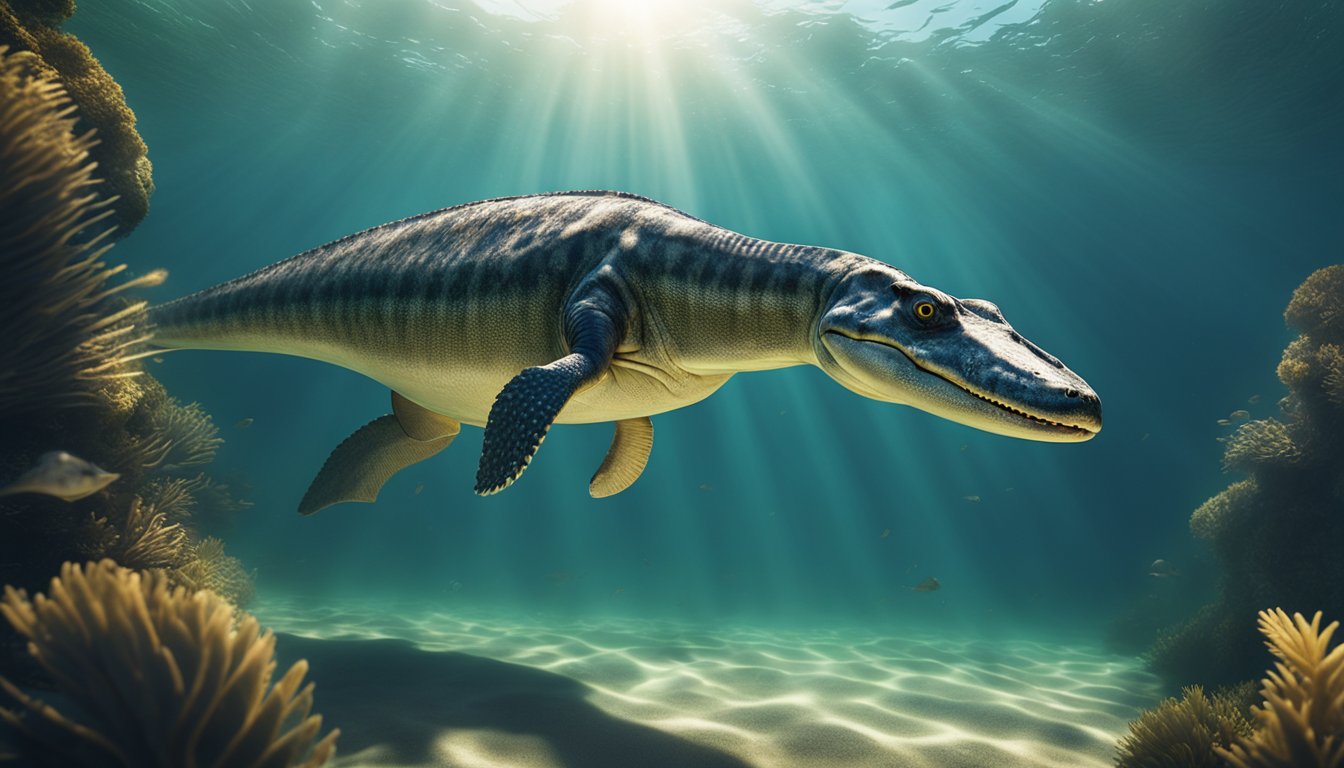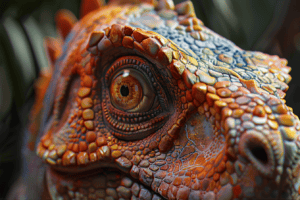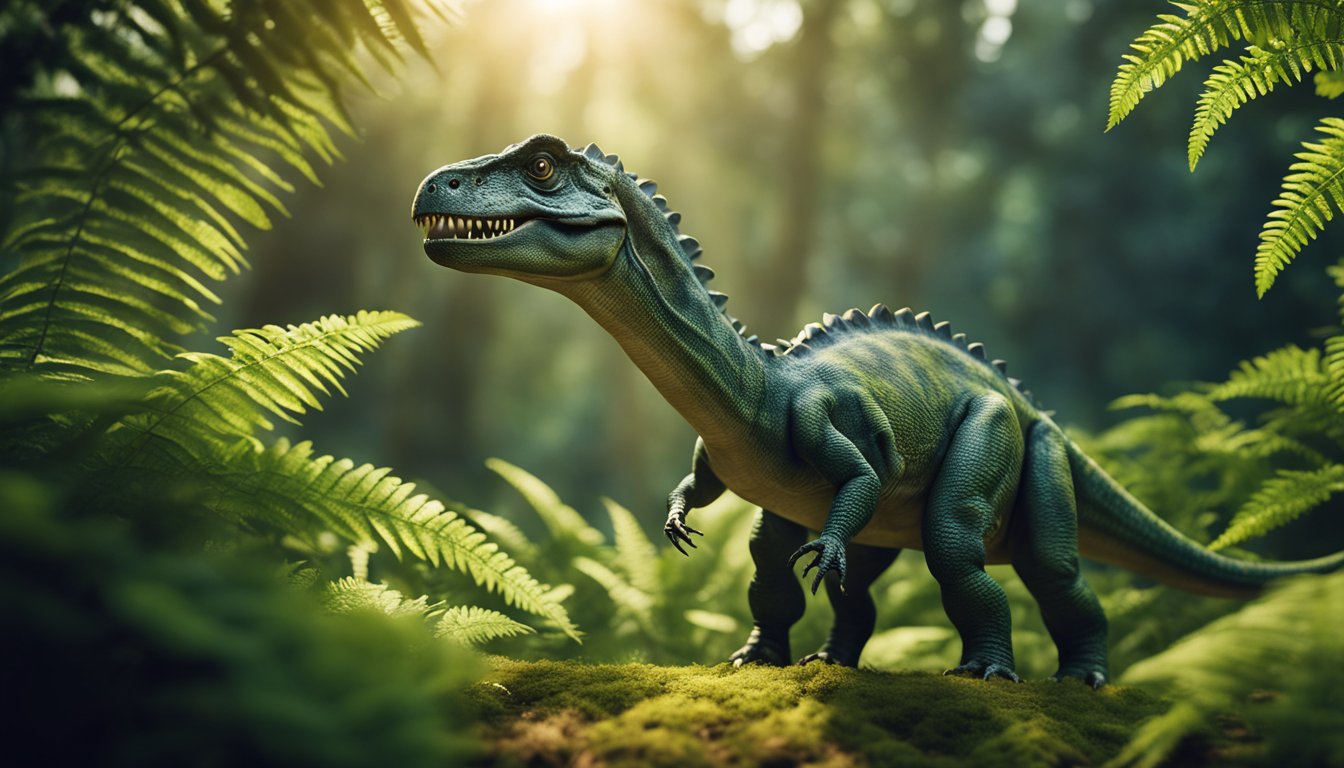Nothosaurus was a sleek marine reptile that swam the seas during the Triassic period, approximately 200-241 million years ago.
It was a member of the Sauropterygia group, which included other marine reptiles such as ichthyosaurs and pachypleurosaurs.
Nothosaurus had a long, slender body with four flippers and a long tail that helped it move gracefully through the water.

Despite its name, which means “false lizard,” Nothosaurus was a true reptile.
It was a carnivore that fed on fish and other small marine animals.
Nothosaurus was one of the dominant groups of marine reptiles of the Triassic, along with the primitive ichthyosaurs like Cymbospondylus.
The nothosaurs were often dubbed the seals of the Triassic due to their streamlined bodies and flippers that allowed them to swim with ease.
Nothosaurus fossils have been found in Northern Africa, Europe, and Asia.
The multiple specimens found provide valuable insight into the anatomy and behavior of this fascinating creature.
Despite going extinct millions of years ago, Nothosaurus continues to capture the imagination of scientists and enthusiasts alike, providing a glimpse into the diverse and fascinating world of prehistoric marine life.
Unveiling the Nothosaurus
The Nothosaurus is a fascinating species of aquatic reptiles that lived in the Triassic era, about 200-241 million years ago.
These marine reptiles were part of the Sauropterygian reptiles family, which also included the Plesiosaur and the Placodont.
The Nothosaurus was a sleek and agile hunter that roamed the ancient seas, preying on small fish and other marine creatures.
Distinctive Features of a Marine Hunter
The Nothosaurus had a unique appearance that set it apart from other marine reptiles of the time.
They had a long and slender body that was perfectly adapted for swimming and hunting in the water.
Their limbs were modified into flippers that helped them move swiftly through the water.
The Nothosaurus had a sharp snout that was filled with teeth that were perfect for catching and holding onto prey.
They also had a long tail that helped them maneuver in the water.
One of the most distinctive features of the Nothosaurus was their ability to breathe air.
They had to come to the surface to breathe, just like modern-day turtles and crocodiles.
This adaptation allowed them to spend more time underwater, hunting and exploring the depths of the sea.
The Family Tree: Sauropterygian Kin
The Nothosaurus was part of the Sauropterygian family, which included a variety of marine reptiles that lived in the Triassic era.
The Sauropterygian reptiles were unique in that they evolved to live in aquatic environments, adapting to the challenges of life underwater.
The Nothosaurus was part of the Nothosauridae family, which included a variety of semi-aquatic reptiles.
The Nothosauridae family was known for their long and slender bodies, which were perfectly adapted for swimming and hunting in the water.
The Nothosaurus was one of the most successful members of this family, thriving in the ancient seas for millions of years.
Fossils of the Nothosaurus have been found all over the world, from Northern Africa to Europe and Asia.
These fossils have given scientists a glimpse into the life of this fascinating marine reptile, helping us understand more about the evolution of life on Earth.
In conclusion, the Nothosaurus was a remarkable species of marine reptiles that lived in the Triassic era.
Their unique adaptations allowed them to thrive in the ancient seas, hunting and exploring the depths of the water.
The Nothosaurus was a true marvel of evolution, and their legacy lives on in the fossils that have been discovered all over the world.
Life in the Triassic Seas

Habitats and Geographic Distribution
During the Triassic period, the world’s continents were still joined together in a giant landmass called Pangaea.
The Triassic seas were shallow and warm, with a coastline that stretched across modern-day Europe, Asia, and Africa.
The Nothosaurus was a marine reptile that thrived in these habitats, adapting to life in the shallow seas and coastlines.
Nothosaurus fossils have been found in many locations around the world, including Germany, China, and Russia.
These reptiles were well-suited to the marine ecosystems of the Triassic period, where they hunted and fed on fish and other marine life.
Diet and Predatory Behavior
Nothosaurus were fierce predators, using their long, slender bodies to swim through the water with ease.
They had sharp teeth that were perfect for catching and eating fish, squid, and other prey.
Nothosaurus were also known to eat smaller marine reptiles, such as young ichthyosaurs.
These reptiles had a unique feeding behavior, using their sharp teeth to grip onto their prey and then shake it vigorously to break it into smaller pieces.
This allowed them to swallow their prey more easily and quickly.
Fun Fact: Nothosaurus were not the only marine reptiles that lived during the Triassic period.
Other marine reptiles, such as ichthyosaurs and plesiosaurs, also thrived in the oceans and coastlines of this time.
In summary, the Nothosaurus was a sleek and agile marine reptile that lived in the shallow seas and coastlines of the Triassic period.
They were fierce predators that fed on fish and other marine life, using their sharp teeth and unique feeding behavior to catch and eat their prey.
Anatomy and Adaptations

Nothosaurus was a sleek and slender marine reptile that lived during the Triassic period.
Its streamlined body, undulating tail, and paddle-like limbs allowed it to move quickly and gracefully through ancient waters.
Swimming through Ancient Waters
Nothosaurus was an excellent swimmer, thanks to its streamlined body and fin-like limbs.
Its slender body helped reduce drag, while the paddle-like limbs allowed it to propel itself through the water.
The undulating tail helped it steer and maintain balance while swimming.
Sensory and Feeding Adaptations
Nothosaurus had a long, thin head with many sharp teeth. The front teeth were longer than the back teeth, which helped it grasp and hold onto prey.
Its nostrils were located on the top of its snout, allowing it to breathe while swimming near the surface.
Nothosaurus also had webbed feet, which helped it swim more efficiently.
Nothosaurus was a fierce predator of the Triassic seas. Its sharp teeth and powerful jaws allowed it to catch and consume a variety of prey.
It likely fed on fish, squid, and other marine animals.
Fun fact: Nothosaurus was not a dinosaur, but a type of marine reptile.
In conclusion, Nothosaurus was a fascinating creature with many unique adaptations that allowed it to thrive in the ancient seas.
Its slender body, undulating tail, and paddle-like limbs made it an excellent swimmer, while its sharp teeth and powerful jaws made it a formidable predator.
The Nothosaurus Legacy

Fossil Discoveries and Research
Nothosaurus, the sleek reptile of the Triassic seas, has left a lasting legacy in the fossil record.
Fossils of this marine reptile have been found in various parts of the world, including North Africa, China, and Europe.
The first Nothosaurus fossils were discovered in Germany in the early 19th century, and since then, paleontologists have uncovered many more specimens.
Through careful study of these fossils, scientists have been able to piece together a better understanding of Nothosaurus and its place in the animal kingdom.
For example, researchers have found evidence that Nothosaurus had air passages separate from its food passages, similar to modern-day crocodilians.
They have also discovered that Nothosaurus likely fed on a variety of prey, including squid, crustaceans, and other invertebrates.
Comparisons with Modern Marine Life
Despite going extinct over 200 million years ago, Nothosaurus has much in common with modern marine life.
In fact, some have likened Nothosaurus to seals, due to its streamlined body and paddle-like limbs.
Others have compared it to pliosaurs and Liopleurodon, two other top predators of the Mesozoic era.
Interestingly, Nothosaurus is not the only member of its family, Nothosauroidea.
Other members include Lariosaurus, which lived during the early Triassic, and Pachypleurosaurs, which lived during the middle Triassic.
These creatures, along with Nothosaurus, were some of the top predators of their time, feeding on a variety of prey.
Nothosaurus also shares some similarities with terrestrial reptiles, such as lizards and snakes.
For example, Nothosaurus likely had a similar skull structure to these animals, with a single opening for both the air and food passages.
However, Nothosaurus had a much more specialized body structure, adapted for life in the water.
In conclusion, Nothosaurus has left a lasting legacy in the field of earth science.
Through careful study of its fossils, scientists have been able to learn more about this ancient reptile and its place in the animal kingdom.
Despite going extinct millions of years ago, Nothosaurus continues to fascinate and inspire researchers and laypeople alike.
Frequently Asked Questions

What kind of environment did the Nothosaurus call home?
Nothosaurus was a marine reptile that lived during the Triassic period, which lasted from about 252 to 201 million years ago.
During this time, the Earth was a very different place than it is today.
The climate was generally warmer and more humid, and the oceans were home to a variety of marine life, including Nothosaurus.
These sleek reptiles were well adapted to life in the water, with streamlined bodies and powerful flippers that allowed them to swim quickly and efficiently.
They lived in shallow seas and lagoons, where they hunted for fish and other small prey.
How large could a Nothosaurus get, and what did its size compare to in modern animals?
Nothosaurus was a relatively small marine reptile, with most species growing to between 2 and 4 meters (6.5 to 13 feet) in length.
This is roughly the same size as a modern-day sea lion or seal.
However, some species of Nothosaurus could grow larger, with one species known to have reached lengths of up to 6 meters (20 feet).
This is about the same size as a large dolphin or small whale.
Can you describe what a Nothosaurus looked like?
Nothosaurus had a long, sleek body that was well adapted for life in the water.
Its head was elongated and pointed, with sharp teeth that were ideal for catching fish and other small prey.
Its eyes were large and positioned high on its head, giving it excellent vision both above and below the water’s surface.
Nothosaurus also had four powerful flippers, which it used to swim quickly and efficiently through the water.
Its body was covered in smooth, streamlined scales, which helped to reduce drag and increase speed.
What was the primary diet of a Nothosaurus, and how did it hunt its prey?
Nothosaurus was a carnivorous reptile, and its primary diet consisted of fish and other small marine animals.
It was an active predator, using its sharp teeth and powerful jaws to catch and kill its prey.
Nothosaurus was also a fast swimmer, which allowed it to chase down its prey with ease.
Once it had caught its prey, Nothosaurus would use its sharp teeth to tear off chunks of flesh and swallow them whole.
Have any Nothosaurus fossils been discovered, and what have they taught us?
Yes, many fossils of Nothosaurus have been discovered over the years, and they have taught us a great deal about these fascinating creatures.
Fossils of Nothosaurus have been found in Europe, Asia, and Africa, and they have helped us to better understand the evolution of marine reptiles during the Triassic period.
By studying these fossils, scientists have been able to learn about Nothosaurus’ anatomy, behavior, and ecology, as well as its relationships to other marine reptiles of the time.
Why did the Nothosaurus become extinct, and when did this happen?
Like many other species of marine reptiles, Nothosaurus went extinct at the end of the Triassic period, around 201 million years ago.
The exact cause of its extinction is not known, but it is thought to have been the result of a combination of factors, including changes in the climate and sea levels, as well as competition from other marine predators.
Despite its extinction, Nothosaurus remains an important part of the evolutionary history of marine reptiles, and its fossils continue to fascinate scientists and enthusiasts alike.







